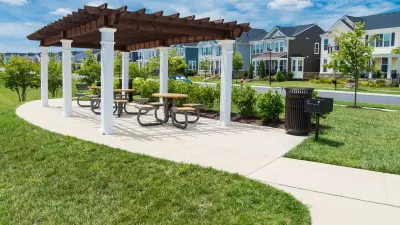Thirty community organizations have come together to deliver a response to Oakland's RFP for a comprehensive planning consultant. It's one of three proposals, but certainly the only one with cartoons.

Every Tuesday and Thursday, from 4 p.m. to 6:30 p.m., Nakia Woods has a meeting to help plan for the future of Oakland.
Woods is the program director at HOPE Collaborative — the acronym stands for “Health for Oakland’s People and Environment.” Those are the regular meeting times for the group’s Youth Action Board, which for the past ten years has brought together Oaklanders aged 14 to 24 from disinvested and marginalized neighborhoods across the Bay Area city.
“Houseless folks, queer folks, folks of color, young people, folks that are differently abled, there’s this misconception that these folks don’t really care about the general plan or city planning process,” says Woods.
Woods recently witnessed Youth Action Board members and other marginalized groups coming together around planning for the future of their neighborhoods. HOPE Collaborative was one of 12 community-based organizations who partnered with the city to lead the East Oakland Neighborhoods Initiative.
From November 2018 to June 2019, the East Oakland Neighborhoods Initiative organized a series of 20 meetings in six neighborhoods across what’s known as “Deep East Oakland” — all historically working-class, predominantly Black and brown neighborhoods that have born the brunt of earlier city planning decisions that have kept them in the path of toxic fumes, water contamination and other pollution. The results were a laundry list of 89 projects and policies residents would like to see funded and implemented, as well as closer connections between all 12 participating organizations.
Oakland now has a once-in-a-generation opportunity to call upon networks and conversations like those, all across the city and not just in Deep East Oakland, as the Oakland planning bureau begins the process of updating the city’s General Plan. It’s a document that guides city zoning and land use decisions and capital investments for the next few decades. The general plan determines what can be built where, shaping almost every aspect of a city’s built environment. Oakland’s current general plan was adopted back in 1998, though parts of it were updated in 2013.
HOPE Collaborative and more than 30 other Oakland community-based groups joined forces to submit “The Oakland People’s Plan,” a joint proposal in response to the city’s RFP in search of an outside consulting group to lead the General Plan update process. The collective, cobbled together in just a few weeks, was one of three finalists to deliver a detailed presentation to city planning staff in July. It’s almost certainly the only one with cartoons.
“Honestly it was a little bit overwhelming, learning about what the general plan is, learning about the possibilities of what could happen, learning about the implications of a general plan that is not equitable,” says Woods. “But business as usual has not worked for us. Business as usual really to me means non-authentic engagement or engagement only with people who are already at the table and involved with city processes and don’t understand the complexities that Oakland residents face, don’t understand racial equity, don’t understand gentrification and having to move out of a city some have called home for generations.”
FULL STORY: Comprehensive Planning Sucks. These Oaklanders Want to Make It Better.

Alabama: Trump Terminates Settlements for Black Communities Harmed By Raw Sewage
Trump deemed the landmark civil rights agreement “illegal DEI and environmental justice policy.”

Planetizen Federal Action Tracker
A weekly monitor of how Trump’s orders and actions are impacting planners and planning in America.

Why Should We Subsidize Public Transportation?
Many public transit agencies face financial stress due to rising costs, declining fare revenue, and declining subsidies. Transit advocates must provide a strong business case for increasing public transit funding.

Understanding Road Diets
An explainer from Momentum highlights the advantages of reducing vehicle lanes in favor of more bike, transit, and pedestrian infrastructure.

New California Law Regulates Warehouse Pollution
A new law tightens building and emissions regulations for large distribution warehouses to mitigate air pollution and traffic in surrounding communities.

Phoenix Announces Opening Date for Light Rail Extension
The South Central extension will connect South Phoenix to downtown and other major hubs starting on June 7.
Urban Design for Planners 1: Software Tools
This six-course series explores essential urban design concepts using open source software and equips planners with the tools they need to participate fully in the urban design process.
Planning for Universal Design
Learn the tools for implementing Universal Design in planning regulations.
Caltrans
Smith Gee Studio
Institute for Housing and Urban Development Studies (IHS)
City of Grandview
Harvard GSD Executive Education
Toledo-Lucas County Plan Commissions
Salt Lake City
NYU Wagner Graduate School of Public Service





























